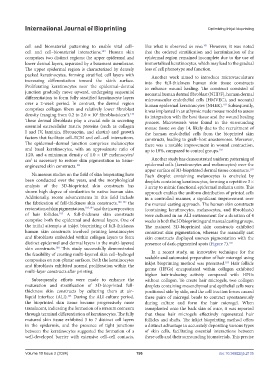Page 204 - IJB-10-2
P. 204
International Journal of Bioprinting Optimizing inkjet bioprinting
cell and biomaterial patterning to enable vital cell– like what is observed in vivo. However, it was noted
101
cell and cell–biomaterial interactions. Human skin that the ordered stratification and keratinization of the
109
comprises two distinct regions: the upper epidermal and epidermal region remained incomplete due to the use of
lower dermal layers, separated by a basement membrane. immortalized keratinocytes, which may lead to the gradual
The upper epidermal region is characterized by densely loss of cell phenotype and function.
packed keratinocytes, forming stratified cell layers with Another work aimed to introduce microvasculature
increasing differentiation toward the skin’s surface. into the full-thickness human skin tissue constructs
Proliferating keratinocytes near the epidermal–dermal to enhance wound healing. The construct consisted of
junction gradually move upward, undergoing sequential neonatal human dermal fibroblast (NHDF), human dermal
differentiation to form fully stratified keratinocyte layers microvascular endothelial cells (HMVEC), and neonatal
over a 2-week period. In contrast, the dermal region human epidermal keratinocytes (NHEK). Subsequently,
102
comprises collagen fibers and relatively lower fibroblast it was implanted in an athymic nude mouse model to assess
density (ranging from 0.2 to 2.0 × 10 fibroblasts/cm ). its integration with the host tissue and the wound healing
3 110
5
These dermal fibroblasts play a crucial role in secreting process. Microvessels were found in the surrounding
essential extracellular matrix proteins (such as collagen mouse tissue on day 14, likely due to the recruitment of
I and IV, laminin, fibronectin, and elastin) and growth the human endothelial cells from the bioprinted skin
factors that facilitate cell–ECM and cell–cell interactions. constructs, leading to graft–host anastomoses. Moreover,
The epidermal–dermal junction comprises melanocytes there was a notable improvement in wound contraction,
and basal keratinocytes, with an approximate ratio of up to 10%, compared to control groups.
102
1:20, and a minimum density of 1.0 × 10 melanocytes/
4
cm is necessary to restore skin pigmentation in tissue- Another study has demonstrated uniform patterning of
2
engineered skin constructs. epidermal cells (keratinocytes and melanocytes) over the
103
upper surface of 3D-bioprinted dermal tissue constructs.
103
Numerous studies on the field of skin bioprinting have Each droplet containing melanocytes is encircled by
been conducted over the years, and the morphological droplets containing keratinocytes, forming a repetitive 3 ×
analysis of the 3D-bioprinted skin constructs has 3 array to mimic functional epidermal melanin units. This
shown high degree of similarities to native human skin. approach enables the uniform distribution of printed cells
Additionally, recent advancements in this field include in a controlled manner, a significant improvement over
the fabrication of full-thickness skin constructs, 100-102 the the manual casting approach. The human skin constructs
restoration of skin pigmentation, 103,104 and the incorporation (containing keratinocytes, melanocytes, and fibroblasts)
of hair follicles. A full-thickness skin constructs were cultured in an ALI environment for a duration of 4
105
comprise both the epidermal and dermal layers. One of weeks in both the 3D bioprinting and manual casting groups.
the initial attempts at inkjet bioprinting of full-thickness The matured 3D-bioprinted skin constructs exhibited
human skin constructs involved printing keratinocytes consistent skin pigmentation, whereas the manually cast
and fibroblasts embedded within collagen layers to form skin constructs displayed uneven pigmentation with the
distinct epidermal and dermal layers in the multi-layered presence of dark-pigmented spots (Figure 7).
103
skin constructs. This study successfully demonstrated
100
the feasibility of creating multi-layered skin cell–hydrogel In a recent study, an innovative technique for the
composites on non-planar surfaces. Both the keratinocytes scalable and automated preparation of hair microgel using
105
and fibroblasts exhibited normal proliferation within the inkjet bioprinting method was presented. Hair follicle
multi-layer constructs after printing. germs (HFGs) encapsulated within collagen exhibited
higher hair-inducing activity compared with HFGs
Subsequently, efforts were made to enhance the without collagen. To create hair microgels, two collagen
maturation and stratification of 3D-bioprinted full- droplets containing mesenchymal and epithelial cells were
thickness skin constructs by culturing them at air– positioned side by side, and the cell traction forces caused
liquid interface (ALI). During the ALI culture period, these pairs of microgel beads to contract spontaneously
101
the bioprinted skin tissue became progressively more during culture and form the hair microgel. When
translucent, indicating the formation of a stratum corneum transplanted onto the back skin of mice, it was reported
through terminal differentiation of keratinocytes. The fully that these hair microgels effectively regenerated hair
matured skin tissue exhibited 3 to 7 distinct cell layers follicles and shafts. The inkjet bioprinting method offers
in the epidermis, and the presence of tight junctions a distinct advantage in accurately depositing various types
between the keratinocytes suggested the formation of a of skin cells, facilitating essential interactions between
well-developed barrier with extensive cell–cell contacts, these cells and their surrounding biomaterials. This precise
Volume 10 Issue 2 (2024) 196 doi: 10.36922/ijb.2135

